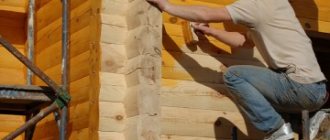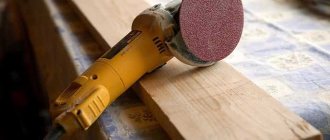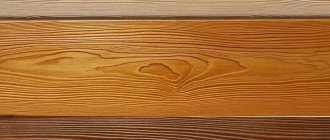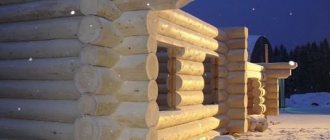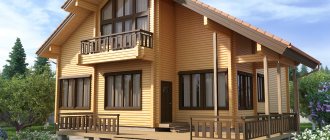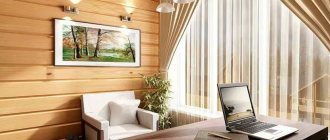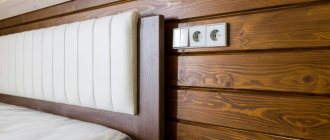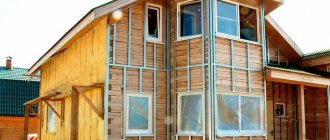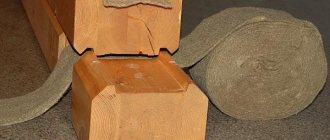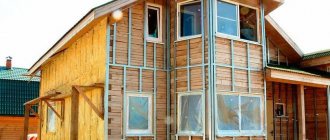Treatment of timber outside the house is necessary for many reasons. Any wooden building requires careful care, since untreated wood is very vulnerable to negative effects of natural and biological origin. It is especially important to provide protection for the outside of a wooden house, the walls of which are constantly exposed to adverse factors: humidity, ultraviolet radiation, temperature changes. How to treat a log house in order to extend its service life and preserve the original appearance of the wood for a long time? Previously, various folk recipes were used for this; today there are many means for treating timber from the outside, which you will learn from the article.
Reasons and purposes of wood processing
All problems that arise in a wooden house are caused by the natural properties of wood. Below are the main defects that appear on a wooden surface and the reasons for their appearance:
- Fungus and mold damage. As a result, the appearance of the log house deteriorates and the wood acquires a blue tint.
- Insect infestation. Pests eat away wood fibers, causing the wood to turn into dust.
- Ultraviolet radiation. The wood fades and takes on an unattractive gray tint.
- High humidity. The logs begin to rot, which threatens the destruction of the structure.
- Uneven evaporation of moisture through the ends and side surfaces of the timber. This leads to the appearance of cracks at the ends of the frame.
All of the problems listed above are typical for any lumber. It doesn’t matter whether the house is built from laminated veneer lumber or imitation timber, these materials are just as vulnerable as a house made from profiled timber. Treating the facade of a wooden house with special means will help prevent such negative manifestations.
Why are external walls treated with bleach?
Bleaching compounds contain chlorine or hydrogen peroxide, which have a detrimental effect on microflora; these products are used to treat the outside of buildings. The operation has a dual purpose:
- Affects spores of all types of fungus,
- Cleans the surface of the timber and the pores of the wood from contaminants.
Before and after applying bleach
Bleaching of the outside of a log house is carried out for preventive purposes and to update the facade; during the period of operation of the building, this operation is repeated periodically. Experts recommend treating walls in this way every time before applying protective impregnations. The most popular products include: “CEDAR (Bleach)”, “Nortex-Bleach” and “Bioshield-2”; a sprayer can be used to apply these solutions.
When treating a house made of timber from the outside
The first treatment of wooden houses is carried out before construction.
This is usually done by immersing the logs in a bath of antiseptic solution. But, as a rule, lumber undergoes primary processing under production conditions. If construction is not planned immediately after transportation, it is necessary to ensure proper storage of the timber. Lumber should be stored in a well-ventilated and dry room or under a canopy, in a place where the timber does not come into contact with the ground.
The second treatment of a timber house is carried out within a few days after completion of construction. It is necessary to use water-soluble compounds that do not interfere with the natural shrinkage that occurs in the wood. The air temperature during processing should be at least 5-7 degrees Celsius. If a log house is erected in winter, when all natural processes freeze (including the activity of microorganisms and insects), processing can be postponed until spring.
After the completion of the shrinkage processes, the third treatment of the house frame is carried out. The exact time depends on the type of lumber and the moisture content of the wood. Processing of imitation timber and laminated timber, materials that have undergone chamber drying, can be carried out immediately after construction. Treatment of a house made of profiled timber can be carried out no earlier than in a year and a half, when the moisture content of the lumber reaches 20%.
Roofing repair work
The roof of an old house will most likely need to be completely redone. After all, the building lasted 40-100 years and the roofing material, in any case, lost its characteristics.
Today, building material manufacturers offer a wide selection of roofing materials. Before starting work, you should thoroughly study each modern roofing material and make a choice.
The choice of building material is influenced by the type of roof. Most often it is pitched. Residential buildings are rarely equipped with a flat roof due to the impossibility of creating an attic. It is used both as a utility room and as ventilation for the house.
Therefore, if an attic is needed, then a sloping or gable roof is erected.
If the building is one floor, then a high roof is built. This design will give the building solidity. And the height increases the performance of the roof. When it rains or snows, moisture will not linger on the roof.
Roof Repair Steps
:
- The old covering is removed and damaged rafters are dismantled.
- Rotten elements of the rafter system are replaced with new ones or completely new rafters are erected.
- Wooden parts are treated with pest control.
- Install new covering.
The attic will not be damp if the roof is hydro- and thermally insulated. To do this, perform the following work:
- Foam or mineral wool is laid between the covering and the rafters.
- The lining is carried out using lining.
- Expanded polystyrene is laid in two layers on the attic floor. It is important that the sheets fit end to end, but do not lie on top of each other at the joints.
- Expanded clay is poured onto polystyrene foam. The backfill layer should be 20 cm.
Several recommendations on how to improve the performance properties of the roof:
- When replacing the roof, gutters are also installed. It is important to place them from the foundation at a distance of two to three meters. Otherwise, rainwater will flood the foundation, and this will negatively affect the condition of the foundation.
- If, during an inspection of the attic, bark beetles or traces of their vital activity are found in the beam, then the damaged parts are replaced with new ones. The beam is cut out and a new log is laid in the vacant space.
Sometimes the roof frame also has to be replaced. All roofing repair work is carried out in dry, warm weather.
Protective products for timber houses
The outer walls of the log house are constantly exposed to unfavorable environmental conditions. Precipitation in the form of snow and rain, changes in street temperature, ultraviolet radiation - all these factors negatively affect the condition of a wooden house. In this regard, owners of wooden houses are interested in the question: what is the best way to treat a log house in order to protect it from the influence of unfavorable natural processes.
Which product to choose for treating a wooden house depends on the climatic characteristics of the region, the tree species and the tasks at hand.
External treatment products have special requirements: they must be resistant to natural factors, and must also provide a high level of wood protection.
There are several groups of products designed to protect a wooden house:
- Antiseptics. The main function of antiseptic preparations is to protect wood from moisture and dampness, from rotting and various types of biological damage (fungi, mold, insects, microbes). There are two types of antiseptics. Impregnating compounds penetrate deeply into the wood structure, coating antiseptics form a protective layer on the surface. This group includes impregnating solutions, waxes and oils for wood. Antiseptic treatment of wood is done in any case, even if subsequent finishing of the facade with decorative materials is planned.
- Fire retardants. These products provide fire protection for wood, which is highly flammable. Logs impregnated with fire retardant can withstand open fire for several hours without igniting.
- Preservative compositions. Such impregnations improve and maintain the good condition of the wood. The preparations prevent cracking, maintain the smoothness of the surface, and create a water-repellent barrier.
- Protective finishing agents simultaneously perform protective and decorative functions. These products include varnishes and paints for wood, which protect wood from adverse influences and decorate the wooden surface.
Recipes of our grandfathers
We didn’t come up with ways to protect wood.
Our ancestors knew how to preserve what was built to last, without resorting to expensive means, but using what was at hand.
Eg:
- Waste from various oils (linseed, hemp, machine) is perfect for treating walls. The only thing you should exclude is sunflower; on the contrary, it will attract insects.
- Firing with a blowtorch. The procedure helps to clog the wood capillaries and stop the movement of moisture through them. As a plus, there is also a pleasant shade of the walls, with the effect of noble types of wood.
- Tar, bitumen or tar. The material is highly flammable, so it can only be applied to those parts that are dug into the ground. For example, pillar posts.
- Copper sulfate will repel insects and prevent mold from developing.
- Drying oil heated to boiling. Absorbs tightly, forming a safe film for many years.
- The gaps between the crowns can be rubbed with a mixture of manure and clay. The method is not the most aesthetic, but it is cheap and practical.
Stages of log processing
Before impregnating the timber with protective compounds, it is necessary to carry out preliminary surface preparation.
If you are treating an old house, you first need to brush the walls to remove dirt and dust. Then, using coarse sandpaper, remove the previous paintwork, blue areas of wood and fungal formations. Next, the surface is sanded. For a fresh log house, this operation is the first. Sanding is necessary to remove visual defects and for better and deeper penetration of impregnating compounds into the wood.
Processing is performed in the following sequence:
- Impregnation of wood with antiseptic solutions. Impregnation for a wooden house must be applied to the main surface in 2-3 layers, the ends of the logs must be treated at least 4-5 times. Each new layer is applied after the previous one has dried, usually the solution dries for about a day.
- Fire retardant treatment. Fire retardants are applied in 2-3 layers approximately 10 days after antiseptic treatment.
- Surface priming. A primer is necessary to save paint and better adhesion of the dye to the wooden surface.
- Finishing is carried out within two months after processing. It is recommended to adhere to these deadlines; if you paint the log house later, the protective compounds may be washed away by precipitation, and the house will be left unprotected.
Experts advise not to violate the recommended processing order; if you perform work in a different sequence, it is impossible to ensure high-quality and reliable protection of the wood.
It must also be remembered that after treatment, the wood becomes protected only for a certain time; no product guarantees eternal protection of the wood. Treatments must be carried out regularly; the outer surfaces of a wooden house must be impregnated with antiseptics every five to seven years.
How to treat a wooden house after construction
To prevent protection from spoiling the feeling of a new wooden house, you need to choose a neutral composition of paints and varnishes. GOOD WOOD uses SEDIPAN products, a water-based acrylic paint. The coating applies smoothly, dries quickly, and leaves no odor.
For exterior painting, we use the WACT 640 line as a primer - the products contain a large amount of antiseptic and colorant, which additionally protects the wall from ultraviolet radiation. For interior decoration, it is enough to use WACT 650 - a paint with a lower antiseptic content. We seal the ends with a special compound WV 024, which completely blocks the sap-conducting channels, without disrupting the moisture and air exchange of the wood.
How to correctly calculate the cost of funds
Industrially made impregnations for log houses are usually sold in the form of a powder or concentrate, which are then diluted with water. The diluted solution is 5-10 times the original volume of the product. For example, from a 5-liter canister you can get about 50 liters of ready-made antiseptic.
The calculation of the product required for treatment is based on a standard consumption of 0.3 liters per 1 m2 for one treatment layer. If you perform a simple calculation, you can calculate that 1 liter of concentrate will be used for a single treatment of an area of 60 m2. Thus, one five-liter canister will be enough for three-layer treatment of a house with an area of 100 m2.
The most effective means for treating the outside of your home
For those who are interested in how to treat timber, how to cover imitation timber, how to protect a timber and log house from insects, mold, rot and fire, we have compiled a list of the most popular and effective products that are suitable for external treatment.
"Senezh". The domestic manufacturer produces tinting and preservative antiseptics based on acrylate and water, bleaches and fire-retardant compounds. Under the Senezh brand, more than twenty types of hard-to-rinse products are produced for treating the facade and bottom of a log house, providing protection for wood for more than ten years.
"Belinka". This brand offers a wide range of protective products that protect wood from moisture, insects, UV radiation and fire.
"Pinotex". Polymer-based products are perfect for internal and external processing of timber, including imitation timber. The products are resistant to large temperature changes and protect the simulated timber from moisture, fungus, and microorganisms.
"Neomid". Antiseptics for external use, protecting wood from biological damage for 6-7 years. The manufacturer also produces fire retardant compounds, wax impregnations, bath oil, and special products for processing ends.
"Tikkurila". The Finnish company produces moisture-resistant preparations that create a protective film on the surface. External wooden surfaces treated with these compounds receive good protection from various atmospheric conditions.
"Aquatex". Inexpensive primers and impregnations made in Russia protect the outer walls of the log house from fungus, moisture and ultraviolet radiation. Available in clear and tinted forms, there are fifteen options in different colors on the market.
carries out all types of work on the territory of Moscow and the Moscow region for finishing a wooden house. The processing of the façade of the log house is carried out by our craftsmen strictly according to technology, taking into account the peculiarities of the structure. All materials we use have the necessary certificates.
You can ask questions, send your application and call a specialist to draw up an estimate using the coordinates located in the “Contacts” section.
If you require legal advice , we can advise you. These are our partners with whom we have been working for several years and trust them to resolve all legal issues.
Calculate the cost of painting and insulating your home right now
